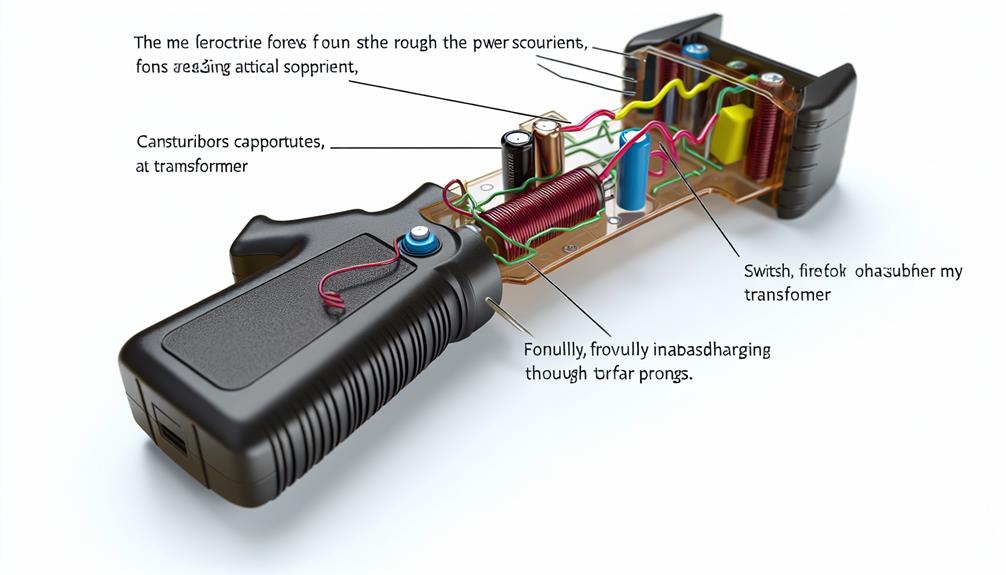
Brainstorm Security Shop

For Orders Over $199

On Any Of Our Products

Details On Refund Page
When considering the effects of stun guns, you might be surprised by the intricate interplay between the body’s responses and the electrical shock delivered. The initial physical manifestations are just the tip of the iceberg when it comes to the potential ramifications of stun gun deployment. Understanding the intricate details of how these devices affect not just your physiology but also your mental well-being is crucial for a comprehensive grasp of their impact. As we delve deeper into the subject, you’ll uncover a complex web of consequences that might make you rethink the common perceptions surrounding stun guns. You can buy my stun guns at brainstormsecurityshop.com at good prices.
The use of stun guns can lead to immediate disruption of neurological functions in individuals subjected to the electric shock. When a stun gun is deployed, it delivers a high-voltage, low-current electrical discharge to the target, affecting nerve activity and brain function. The electric shock interferes with the normal transmission of signals along the nerves, causing a sudden and intense stimulation of the nervous system.
This disruption of nerve activity can result in a variety of immediate effects on the brain. The electrical current can overwhelm the nervous system, leading to confusion, disorientation, and temporary incapacitation. In some cases, stun gun shocks may also cause effects such as dizziness, loss of balance, and even loss of consciousness.
Understanding how stun guns impact nerve activity and brain function is crucial for evaluating their potential risks and benefits. By analyzing the neurological impact of stun guns, researchers can better comprehend the mechanisms behind their effects and develop strategies to minimize harm while maximizing effectiveness.
Upon receiving an electric shock from a stun gun, your muscles may involuntarily contract due to the disruption of normal neurological signals. This abrupt stimulation can trigger a rapid muscle contraction, causing a temporary loss of control over your movements.
The muscle contraction induced by a stun gun can lead to a fatigue response, as your muscles may quickly become exhausted from the intense stimulation. This fatigue response can vary depending on the duration and intensity of the shock delivered.
The impact on muscle strength following a stun gun shock is notable. The sudden and forceful contraction can temporarily diminish your muscle strength, affecting your ability to move or resist against external forces.
Recovery time from the muscular effects of a stun gun shock can vary among individuals. Factors such as overall health, duration of the shock, and individual tolerance levels play a role in determining how quickly muscle function returns to normal.
Understanding the muscular response to a stun gun shock is crucial in comprehending the immediate physical effects of this self-defense tool.
Receiving an electric shock from a stun gun can lead to noticeable impacts on your cardiovascular system. The sudden jolt of electricity can result in an increase in both blood pressure and heart rate. This response is triggered by the body’s natural fight-or-flight reaction to stress and danger.
When exposed to a stun gun, your blood pressure may rise significantly due to the surge of adrenaline released in your body. This spike in blood pressure is a result of the constriction of blood vessels, which forces the heart to work harder to pump blood throughout the body.
Simultaneously, your heart rate is likely to escalate as well. The electrical shock prompts the heart to beat faster as it tries to circulate oxygen and nutrients to vital organs in response to the perceived threat. This increase in heart rate is part of the body’s attempt to prepare you for a potential physical confrontation or escape.
Experiencing an electric shock from a stun gun can lead to alterations in how you perceive pain. When a stun gun is deployed, the electrical current disrupts normal sensory processing in your body, causing a surge of intense pain. This sudden and overwhelming sensation can significantly lower your pain tolerance, making even minor discomfort feel more pronounced.
Additionally, the fear response triggered by the sudden shock can further amplify your perception of pain. The release of adrenaline in response to the perceived threat can heighten your sensitivity to pain, creating a feedback loop where the more pain you feel, the more your body reacts with fear and adrenaline, intensifying the overall experience.
Therefore, the combination of disrupted sensory processing, decreased pain tolerance, and the physiological effects of the fear response and adrenaline release can result in a distorted pain perception when subjected to a stun gun.
Understanding these mechanisms is crucial in evaluating the impact of stun guns on individuals’ pain experiences.

The use of stun guns can pose potential health risks to individuals subjected to the electrical shock, warranting a closer examination of the physiological impacts. Legal implications surrounding the use of stun guns highlight the importance of understanding and mitigating these risks.
Safety concerns arise from the potential for adverse effects on the cardiovascular system and the nervous system, which could lead to serious medical emergencies.
Misuse prevention strategies are crucial to minimize the health risks associated with stun gun usage. Proper training on the appropriate use of stun guns can help reduce the likelihood of injuries or complications.
Additionally, strict regulations and guidelines regarding the deployment of stun guns are essential to ensure the safety of both individuals using these devices and those on the receiving end.
Understanding the potential long-term consequences of stun gun usage is imperative for assessing the overall impact on individuals’ health and well-being. When considering cognitive function, studies suggest that repeated exposure to stun guns may lead to disruptions in cognitive processes. This could manifest as difficulties in memory retention, concentration, and decision-making abilities over time.
Moreover, behavior changes are another critical aspect to consider. Prolonged or frequent use of stun guns has been linked to alterations in behavior, such as increased aggression or anxiety. These changes in behavior patterns could have lasting effects on an individual’s mental well-being and interpersonal relationships.
Therefore, it’s essential to acknowledge the potential long-term consequences of stun gun usage on cognitive function and behavior changes to make informed decisions regarding their use. Monitoring for any signs of cognitive impairment or behavioral shifts in individuals who’ve been exposed to stun guns over an extended period is crucial to address any emerging issues promptly.
Considering the potential long-term consequences of stun gun usage on cognitive function and behavior changes, it’s important to explore the psychological implications associated with repeated exposure to these devices.
One significant psychological implication is the risk of emotional trauma and fear response. Individuals subjected to stun gun deployment may experience heightened levels of anxiety, fear, and emotional distress, potentially leading to long-lasting psychological effects. The intense and sudden nature of the electrical discharge from a stun gun can trigger a fear response that may persist even after the immediate threat has passed. This fear can contribute to increased stress levels and impact mental health, potentially exacerbating existing anxiety levels.
Repeated exposure to stun guns can also lead to psychological desensitization, where individuals may become more tolerant of violence or aggression, affecting their behavior and emotional responses. Understanding and addressing these psychological implications are crucial in evaluating the overall impact of stun gun usage on individuals’ mental well-being and emotional stability.
In conclusion, the effects of stun guns on the human body are significant and multifaceted. From disrupting neurological functions to altering pain perception and cardiovascular responses, stun guns can have immediate and long-term consequences on both physical and mental well-being.
Understanding the potential health risks and psychological implications of stun gun usage is crucial in ensuring the safety and welfare of individuals in various situations.
